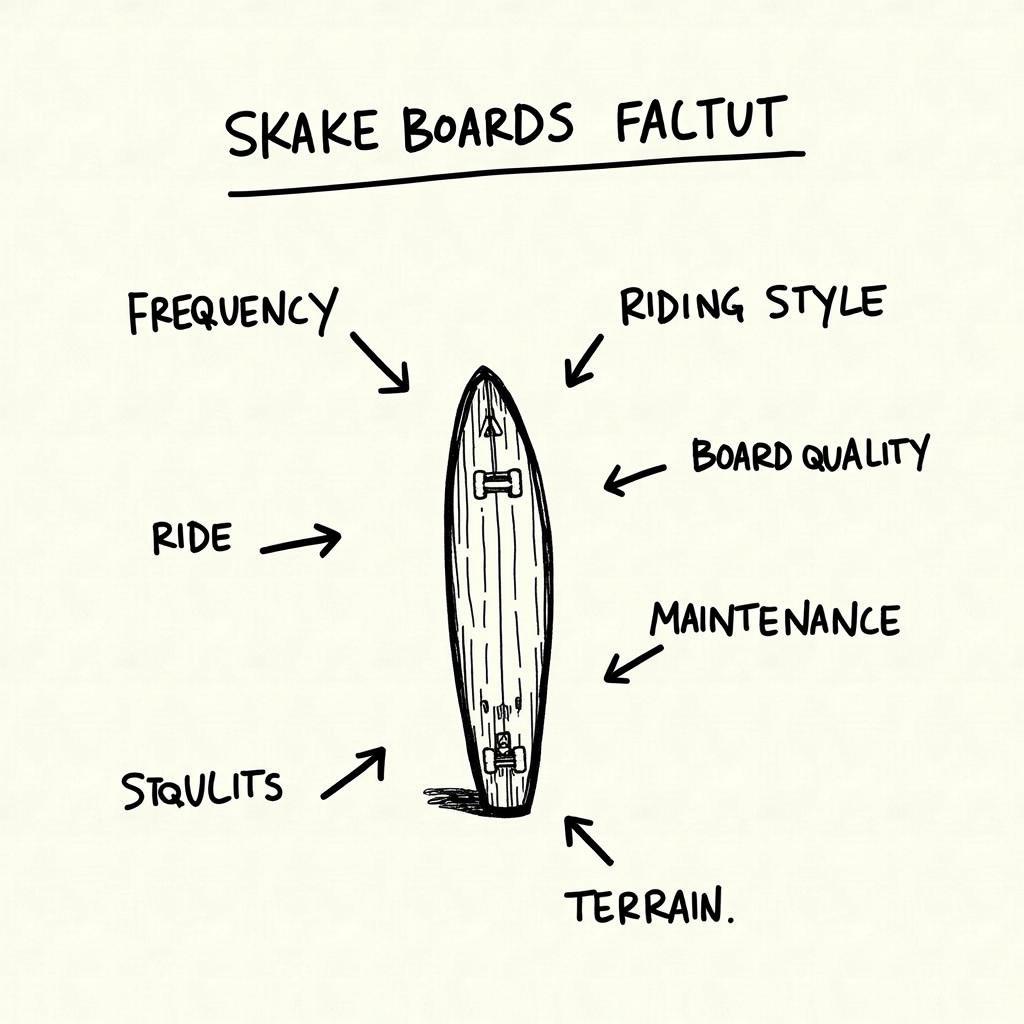How Long Does a Skateboard Last?
October 14, 2024Knowing how long your skateboard will last is a question that pops into every skater’s mind at some point. After all, you’re putting your time, effort, and hard-earned cash into your setup. Unfortunately, there isn’t a magical number of days, months, or years. A skateboard’s lifespan depends on a variety of factors, from riding frequency and style to board quality and maintenance.
 Factors Affecting Skateboard Lifespan
Factors Affecting Skateboard Lifespan
Riding Frequency and Intensity: The More You Skate, the Quicker it Wears
Let’s face it: skateboards aren’t designed to last forever. They’re built for performance and, inevitably, wear and tear. Think of it like this: the more miles you put on your car, the sooner it needs new tires or an oil change. The same principle applies to skateboarding.
Frequent skating, especially aggressive riding styles involving lots of tricks, grinds, and landings, will naturally wear down your board faster. Components like the deck (the wooden platform you stand on), wheels, and bearings take the brunt of the impact, leading to eventual wear and tear.
The Impact of Riding Style: From Casual Cruiser to Hardcore Thrasher
Your riding style plays a significant role in how long your skateboard lasts. A casual cruiser who enjoys mellow rides around the park will likely get more life out of their board compared to a street skater who subjects their setup to intense grinds and stair sets.
Here’s a breakdown of how different riding styles can impact a skateboard’s lifespan:
- Cruising: The most forgiving style on your board, cruising generally involves smooth rides on pavements and bike paths. Skateboards used for cruising tend to last longer due to less stress on the components.
- Street Skating: This style involves tricks, grinds, and jumps, placing higher stress on the deck, trucks, and wheels. Expect more frequent replacements, especially for the deck and wheels.
- Vert Skating: Riding ramps and performing aerial tricks in skateparks puts immense pressure on the board, especially during landings. Vert skaters often go through decks and wheels faster.
- Longboarding: This style, focused on speed and carving, generally results in less wear and tear compared to street or vert skating. Longboards tend to have a longer lifespan, especially when well-maintained.
 Impact of Riding Styles on Skateboard Lifespan
Impact of Riding Styles on Skateboard Lifespan
Quality Matters: Investing in a Durable Skateboard
Just like any other product, the quality of your skateboard significantly impacts its lifespan. A high-quality skateboard, crafted from durable materials and assembled with precision, will naturally withstand more abuse and last longer than a cheaply made board.
When choosing a skateboard, consider these factors:
- Deck Material: Opt for a deck made from hard rock maple. This wood type offers excellent durability and pop (the board’s ability to spring back after landing a trick).
- Trucks: Look for trucks made from durable aluminum alloy. Reputable brands often use high-grade aluminum for enhanced strength and responsiveness.
- Wheels: Choose wheels with a durometer rating suitable for your riding style and terrain. Harder wheels (higher durometer) are more durable for street skating, while softer wheels (lower durometer) offer a smoother ride on rougher surfaces.
- Bearings: Invest in quality bearings with a high ABEC rating (Annular Bearing Engineering Committee). Higher ABEC ratings generally indicate better precision and smoother rolling, which can contribute to longer bearing life.
Maintenance is Key: Extending the Life of Your Skateboard
Proper maintenance plays a crucial role in maximizing your skateboard’s lifespan. Just like a car needs regular tune-ups, your skateboard requires some TLC to stay in top shape. Here are some essential maintenance tips:
- Clean Your Bearings: Regularly remove dirt and debris from your bearings to ensure smooth rolling and prevent premature wear.
- Tighten Loose Hardware: Check and tighten any loose screws or nuts on your trucks, wheels, and deck regularly. Loose hardware can affect performance and lead to component damage.
- Inspect Your Deck: Regularly inspect your deck for cracks, splinters, or signs of delamination (layers of wood separating). Addressing minor issues early can prevent them from escalating into major problems.
- Store Your Skateboard Properly: Avoid exposing your skateboard to extreme temperatures or prolonged moisture. Store it in a cool, dry place when not in use to prevent warping or damage.
When to Retire Your Skateboard: Recognizing the Signs
Even with the best care, there comes a time when it’s safer and more practical to retire your trusty skateboard. Here are some telltale signs that it might be time for a new setup:
- Severe Deck Damage: If your deck has major cracks, deep razor tail, or significant delamination, it’s time to retire the board. These issues compromise the deck’s integrity and pose a safety risk.
- Worn-Out Wheels: Wheels with flat spots, chunks missing, or severely worn-down urethane are due for replacement. Riding on worn-out wheels affects performance and can be dangerous.
- Damaged Trucks: If your trucks are bent, cracked, or have excessive play (looseness) that can’t be fixed by tightening, it’s best to replace them.
 Signs of a Worn-Out Skateboard
Signs of a Worn-Out Skateboard
Conclusion
Ultimately, the lifespan of your skateboard is a moving target influenced by numerous factors. While you can’t stop the wear and tear that comes with riding, you can significantly extend your board’s life by understanding how riding style, quality, and maintenance play a role. Remember, a well-maintained skateboard not only lasts longer but also performs better and provides a safer riding experience.